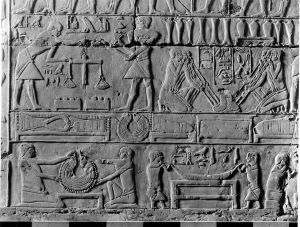
01
DecNew England Chapter: "Defining the Ideal Body: A Reexamination of Depictions of Dwarfism in Old Kingdom Art"
Registration is required
Presented by: Emily Smith-Sangster
- 6:00 PM EDTNew England (Boston)
- Zoom
- + Add to Calendar
Lecture Information
Jewelers with dwarfism from the tomb of Mereruka (Oriental Institute of Chicago, OIP 31)
Examinations of bodies in Egyptian art often rely on the idea that what is being represented is the “ideal”- a term that has almost always been subconsciously defined in reference to the standards of the culture and time from which the art historian or archaeologist hails. This is particularly notable in the study of depictions of individuals with dwarfism- depictions that have often been assigned a semiotic role, or used the discuss the “assigned roles” of individuals with disabilities in the past; a discussion that usually relies on a modern, ableist perspective. While some scholars have begun turning the proverbial tide, the wide spread use of these methods of analysis in the literature, and their colloquial use within the field, continues to other individuals with different bodies, and stunts any true discussion about the significance behind the depiction of this multivalent group in the artistic corpus. This paper works to address this issue through the reexamination of depictions of individuals with dwarfism, using the Old Kingdom material as a case study. The analysis will demonstrate that, in contrast to prior conclusions on this topic, depictions of individuals with dwarfism in this period serve no iconographical role. Further, there is no artistic evidence to suggest that individuals with dwarfism were pigeonholed into specific social roles, such as dancer, due to their bodies. Instead, this paper pushes to understand what allowed for such a negotiation of conventions in the depictions of these bodies, concluding that the depictions of this body type may have been viewed as equally idealized as any other body in the artistic corpus of the Old Kingdom. In doing so, this reanalysis will help the field to move closer to understanding the manner in which individuals with dwarfism were perceived and represented in Old Kingdom society- as a completely normal subset of the societal whole.
Speaker Bio
Emily Smith-Sangster is a Ph.D. Candidate in Egyptian Art and Archaeology at Princeton University. Her research focuses on questions of post-mortem identity expression in the New Kingdom, with primary concentration on the site of Abydos. Her work interacts with themes of gender, disability, sensorialism, and embodiment.

